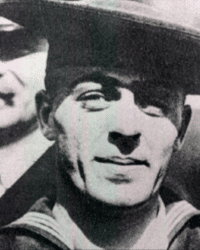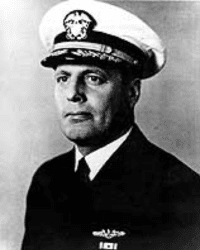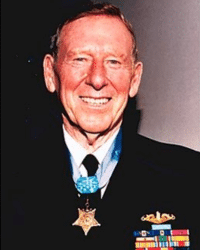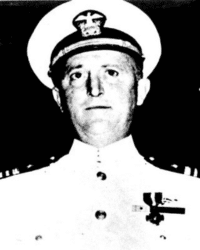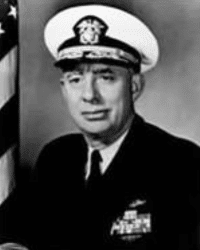CDR George L. Street III
1945
The President of the United States in the name of The Congress takes pleasure in presenting the MEDAL OF HONOR to
COMMANDER GEORGE L. STREET III
UNITED STATES NAVY
for service as set forth in the following CITATION:

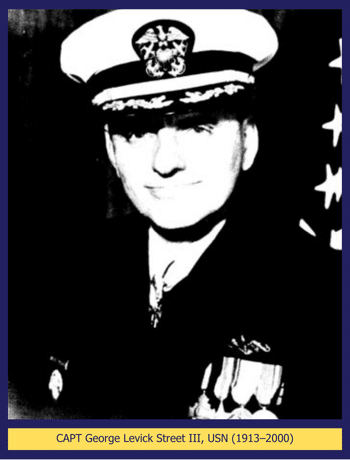
One of seven submariners to receive the Medal of Honor in World War II, George Levick Street, III earned that distinction for the extraordinary success of his first war patrol in USS Tirante (SS-420), and particularly for his daring attack on Japanese shipping in a harbor at Quelpart Island, south of Korea, in April 1945. Moreover, he then repeated that exploit in a raid on the port of Ha Shima near Nagasaki only two months later.
Geroge Levick Street III was born in Richmond, VA on 27 July 1913 and entered the Navy between the wars. When he reported aboard Tirante as her first Commanding Officer in November 1944, het had already made nine war patrols on USS Gar (SS-206). His Executive Officer, then-LT Edward L. “Ned” Beach, later to become well known as the author of Run Silent, Run Deep and many other books of naval literature, was himself a veteran of ten patrols on USS Trigger (SS-237). After shakedown training in Long Island Sound and off Panama and Oahu, Tirante departed Pearl Harbor on 3 March 1945 for her first war patrol and headed via Saipan for the approaches to Nagasaki west of Kyushu, athwart Japanese communication lines from Shanghai, Dairen, and Tsingtao. On 25 March, she claimed her first victim, the 700-ton tanker Fuji Maru off Kagoshima and three days later sank the 1,200-ton freighter Nase Maru. The ensuing counter-attack by Japanese escorts kept Tirante down for seven hours, but she managed to slip away without damage and sank a 100-ton lugger on 31 March.
Upon the U.S. invasion of Okinawa on 1 April, Tirante was ordered to guard the western exit of the Japanese Inland Sea against a possible sortie of enemy heavy units in response. When relieved of those guard duties, Street moved Tirante north to the southern coast of Korea in hopes of finding a target or two among the increasingly few at sea that late in the war. On 6 April, however, word arrived that the Japanese super-battleship Yamato and its escorts had indeed sortied from the Inland Sea, and Street moved south again to position Tirante for an attack in case the Japanese were heading for Sasebo. Yamato, however, was sunk on the 7th by aircraft from Task Force 58, and Street lost no time in returning northward to sink a small freighter that same day, which unfortunately could not be confirmed by postwar records.
With information derived from broken Japanese naval codes, Tirante was then vectored to intercept a small convoy from Shanghai bringing Japanese soldiers and sailors back to the homeland. Street maneuvered into position for an ambush and fired six torpedoes at two different ships, succeeding in sinking the Nikko Maru, a 5,500-ton transport. As the Japanese escorts turned to attack, Tirante countered with a homing torpedo at one of them, and although “breaking-up” noises were heard, the sinking could never be confirmed after the war.
Tirante had resumed patrolling the East China Sea between Shanghai and Quelpart Island south of Korea when new intelligence arrived reporting that an important transport had anchored with its escorts in a confined harbor on the northern coast of the island. With Japanese shipping virtually driven from the seas, Street realized that he would have to take the fight into the harbor to score a kill. On the night of 13 April, Tirante put the ten-fathom curve behind her and headed in on the surface, through several miles of shallow water guarded by patrol vessels, shore-based radar, and minefields. Inside the harbor, with Ned Beach manning the bridge, Street fired three torpedoes at the transport, Juzan Maru, 4,000 tons, which disintegrated in a blinding explosion that lit up the whole scene. With Tirante illuminated by the burning transport, the Japanese frigate, Nomi, and a small coastal defense vessel turned to the attack as Street maneuvered to make good his escape. Pausing only long enough to launch three torpedoes at his pursuers, Street headed back out to sea at flank speed as the two Japanese escorts became his second and third victims that night and blew up. Her torpedoes expended, Tirante headed for home via Midway, but managed to capture two downed Japanese airmen before ending her patrol on 26 April 1945.
For his relentless initiative and remarkable courage in the action at Quelpart, and with six ships of nearly 13,000 tons credited to Tirante’s first patrol, then-CDR Street was awarded the Congressional Medal of Honor in October 1945, while Ned Beach received the Navy Cross and went on to his own command. The ship herself was awarded the Presidential Unit Citation.
The “rest of the story” is almost more incredible. In June 1945, on Tirante’s second war patrol, Street carried off a near repetition of his Quelpart attack in making a long submerged approach in the shallow waters off Nagasaki to torpedo the 2,200-ton Hakuju Maru moored alongside a colliery on the island of Ha Shima. The gun crew of the wounded Japanese ship took Tirante’s protruding radar mast under fire, and Street had to expend two more torpedoes to finish the job. Tirante then surfaced to clear the area at high speed amid a hail of gunfire from Japanese shore batteries on the surrounding headlands. The ship and her crew lived to tell the tale, and only the end of the war in mid-August 1945 cut short her third patrol.
Submarine Force Recipients
Click on the photo or name to read more about each person who received the Medal of Honor for actions while a submariner.
